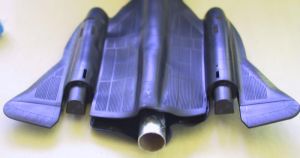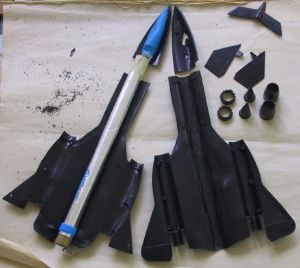Scratch SR-71 Blackbird Plastic Model Conversion
Scratch - SR-71 Blackbird {Scratch}
Contributed by Scott Turnbull
| Manufacturer: | Scratch |

Brief:
This describes a semi-successful plastic model conversion of a small Revell SR-71 Blackbird kit. A 13mm motor mount was added to the kit.
Modifications:
This was undertaken as part of the EMRR 2006 Rocketry Challenge. It represents my first attempt at PMC.
I chose the kit for its classic styling, potential for stable rocket powered flight, and apparent ease of conversion. Various flying rocket versions of this plane have been available over the years. A ready to fly starter set is currently on store shelves. The challenge of rolling my own, albeit a smaller version, drew me to this one.
Upon opening the kit I found it to be a very simple build, consisting mostly of an upper an lower fuselage/wing combination. A narrow channel ran from nose to tail along the central body, narrowing at each end.
 While an 18mm would offer more thrust to power a heavy kit, the restrictions of the airframe barely lent itself to a 13mm mount. I determined that a Gnome body tube was a nearly custom fit for the main body channel. Even that small tube didn't fit inside the kit as shipped.
While an 18mm would offer more thrust to power a heavy kit, the restrictions of the airframe barely lent itself to a 13mm mount. I determined that a Gnome body tube was a nearly custom fit for the main body channel. Even that small tube didn't fit inside the kit as shipped.
I used a heat gun to soften the airframe and press it around a length of copper pipe. This stretched the central core of the ship until the Gnome tube could be sandwiched between the two halves. I also heated and deformed the Gnome nose cone to fit it into the nose of the SR-71.
Once the rough heat molding of the airframe was done, I used a razor saw to slice the SR-71 nose off. This would be glued around the Gnome nose cone to provide a press fit into the Gnome tube inside the rear airframe.
I used Gorilla Glue to bond the Gnome tube to the upper airframe. I used Testors liquid model cement to glue the airframe together around the body tube. Once the airframe was assembled, some additional spot heating with the heat gun was used to fine tune the fit.
 An elastic shock cord was fitted to the Gnome tube prior to sealing it within the SR-71. To help increase stability, I packed the nose cone with BBs and plastic model cement.
An elastic shock cord was fitted to the Gnome tube prior to sealing it within the SR-71. To help increase stability, I packed the nose cone with BBs and plastic model cement.
The final assembly consisted of using Testors liquid plastic cement to glue on the tail fins and engine details. A second launch lug from a Gnome kit was separated from it's ring and glued to the bottom of the SR-71 near its center of gravity.
Construction:
The base model is a snap together SR-71 Blackbird kit by Revell. To that was added a slightly crumpled body tube from a Gnome kit, along with the Gnome nosecone and engine retainer.
The Revell kit is nicely detailed and contains few parts. That means few seams to worry about splitting during thrust and recovery.

Flight and Recovery:
This is a very small body tube for any kind of chute. The forming of the tube into an oval to fit inside the SR-71 frame further reduced the useable space. I installed a streamer in the rocket knowing it would not be a gentle landing.
I chose an A10-3T motor. This is a hefty model for a 13mm engine. A small amount of cellulose insulation was used to protect the streamer.
On the first flight, the SR-71 boosted clean off the rod, got to about 20 feet, performed a couple of tail over nose flips, then kicked out the engine before belly flopping in the grass unharmed. The wadding and streamer offered more resistance than the engine hook.
A second flight with the engine hook taped to the A10-3T engine went almost the same as the first flight. There was a seemingly good boost for the first 20 feet, then a couple of tail over nose flips. This time the model belly flopped to the ground and spit out the streamer in the grass.
Summary:
This is apparently still a marginally stable configuration. More nose weight might be the answer, but that would likely outpace the ability of even the A10 to loft the model.
Those two engine nacelles mounted midway out on each wing offer a tantalizing opportunity for parallel staging. I am considering how boosters could be fit into the engine nozzles for extra thrust off the rod.
Sponsored Ads
 |
 |











